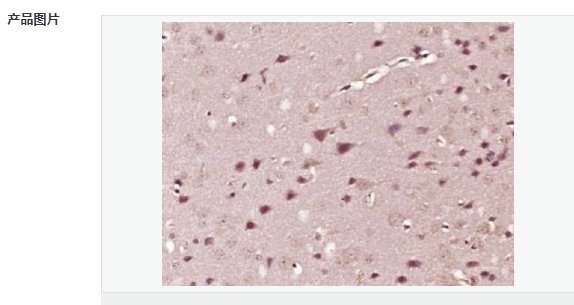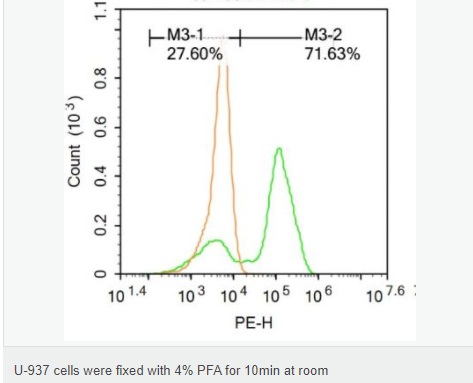
货号
产品规格
售价
备注
BN41731R-50ul
50ul
¥1486.00
交叉反应:Mouse,Human(predicted:Horse,Cow,Dog,Chicken,Rat) 推荐应用:IHC-P,IHC-F,IF,Flow-Cyt,ELISA
BN41731R-100ul
100ul
¥2360.00
交叉反应:Mouse,Human(predicted:Horse,Cow,Dog,Chicken,Rat) 推荐应用:IHC-P,IHC-F,IF,Flow-Cyt,ELISA
BN41731R-200ul
200ul
¥3490.00
交叉反应:Mouse,Human(predicted:Horse,Cow,Dog,Chicken,Rat) 推荐应用:IHC-P,IHC-F,IF,Flow-Cyt,ELISA
| 英文名称 | NDRG1 |
| 中文名称 | 分化相关基因NDRG1抗体 |
| 别 名 | Cap43; N-myc downstream regulated gene 1; TDD5; 42 kDa; cap43; cmt4d; Differentiation related gene1 protein; Drg 1; drg1; gc4; hmsnl; Human mRNA for RTP complete cds; N myc downstream regulated gene 1 protein; Ndr 1; NDRG 1; Nickel specific induction protein Cap43; Nmyc downstream regulated gene1; Protein NDRG1; Protein regulated by oxygen 1 ; Protein regulated by oxygen1; proxy1; reducin; Reducing agents and tunicamycin responsive protein; rit42; rtp; targ1; tdds; tunicamycin-responsive protein. |
| 研究领域 | 细胞生物 神经生物学 转运蛋白 |
| 抗体来源 | Rabbit |
| 克隆类型 | Polyclonal |
| 交叉反应 | Human, Mouse, (predicted: Rat, Chicken, Dog, Cow, Horse, ) |
| 产品应用 | ELISA=1:5000-10000 IHC-P=1:100-500 IHC-F=1:100-500 Flow-Cyt=1ug/test IF=1:100-500 (石蜡切片需做抗原修复) not yet tested in other applications. optimal dilutions/concentrations should be determined by the end user. |
| 分 子 量 | 43kDa |
| 细胞定位 | 细胞核 细胞浆 细胞膜 |
| 性 状 | Liquid |
| 浓 度 | 1mg/ml |
| 免 疫 原 | KLH conjugated synthetic peptide derived from human NDRG1:201-300/394 |
| 亚 型 | IgG |
| 纯化方法 | affinity purified by Protein A |
| 储 存 液 | 0.01M TBS(pH7.4) with 1% BSA, 0.03% Proclin300 and 50% Glycerol. |
| 保存条件 | Shipped at 4℃. Store at -20 °C for one year. Avoid repeated freeze/thaw cycles. |
| PubMed | PubMed |
| 产品介绍 | This gene is a member of the N-myc downregulated gene family which belongs to the alpha/beta hydrolase superfamily. The protein encoded by this gene is a cytoplasmic protein involved in stress responses, hormone responses, cell growth, and differentiation. The encoded protein is necessary for p53-mediated caspase activation and apoptosis. Mutations in this gene are a cause of Charcot-Marie-Tooth disease type 4D, and expression of this gene may be a prognostic indicator for several types of cancer. Alternatively spliced transcript variants encoding multiple isoforms have been observed for this gene. [provided by RefSeq, May 2012] Function: Stress-responsive protein involved in hormone responses, cell growth, and differentiation. Acts as a tumor suppressor in many cell types. Necessary but not sufficient for p53/TP53-mediated caspase activation and apoptosis. Has a role in cell trafficking, notably of the Schwann cell, and is necessary for the maintenance and development of the peripheral nerve myelin sheath. Required for vesicular recycling of CDH1 and TF. May also function in lipid trafficking. Protects cells from spindle disruption damage. Functions in p53/TP53-dependent mitotic spindle checkpoint. Regulates microtubule dynamics and maintains euploidy. Subunit: Interacts with RAB4A (membrane-bound form); the interaction involves NDRG1 in vesicular recycling of CDH1. Subcellular Location: Cytoplasm, cytosol. Cytoplasm, cytoskeleton, centrosome. Nucleus. Cell membrane. Note=Mainly cytoplasmic but differentially localized to other regions. Associates with the plasma membrane in intestinal epithelia and lactating mammary gland. Translocated to the nucleus in a p53/TP53-dependent manner. In prostate epithelium and placental chorion, located in both the cytoplasm and in the nucleus. No nuclear localization in colon epithelium cells. In intestinal mucosa, prostate and renal cortex, located predominantly adjacent to adherens junctions. Cytoplasmic with granular staining in proximal tubular cells of the kidney and salivary gland ducts. Recruits to the membrane of recycling/sorting and late endosomes via binding to phosphatidylinositol 4-phosphate. Associates with microtubules. Colocalizes with TUBG1 in the centrosome. Cytoplasmic location increased with hypoxia. Phosphorylated form found associated with centromeres during S-phase of mitosis and with the plasma membrane. Tissue Specificity: Ubiquitous; expressed most prominently in placental membranes and prostate, kidney, small intestine, and ovary tissues. Also expressed in heart, brain, skeletal muscle, lung, liver and pancreas. Low levels in peripheral blood leukocytes and in tissues of the immune system. Expressed mainly in epithelial cells. Also found in Schwann cells of peripheral neurons. Reduced expression in adenocarcinomas compared to normal tissues. In colon, prostate and placental membranes, the cells that border the lumen show the highest expression. Post-translational modifications: Under stress conditions, phosphorylated in the C-terminal on many serine and threonine residues. Phosphorylated in vitro by PKA. Phosphorylation enhanced by increased intracellular cAMP levels. Homocysteine induces dephosphorylation. Phosphorylation by SGK1 is cell cycle dependent. DISEASE: Defects in NDRG1 are the cause of Charcot-Marie-Tooth disease type 4D (CMT4D) [MIM:601455]; also known as hereditary motor and sensory neuropathy Lom type (HMSNL). CMT4D is a recessive form of Charcot-Marie-Tooth disease, the most common inherited disorder of the peripheral nervous system. Charcot-Marie-Tooth disease is classified in two main groups on the basis of electrophysiologic properties and histopathology: primary peripheral demyelinating neuropathy and primary peripheral axonal neuropathy. Demyelinating CMT neuropathies are characterized by severely reduced nerve conduction velocities (less than 38 m/sec), segmental demyelination and remyelination with onion bulb formations on nerve biopsy, slowly progressive distal muscle atrophy and weakness, absent deep tendon reflexes, and hollow feet. By convention, autosomal recessive forms of demyelinating Charcot-Marie-Tooth disease are designated CMT4. Similarity: Belongs to the NDRG family. SWISS: Q92597 Gene ID: 10397 Database links: Entrez Gene: 10397 Human Entrez Gene: 17988 Mouse Omim: 605262 Human SwissProt: Q92597 Human SwissProt: Q62433 Mouse Unigene: 372914 Human Unigene: 30837 Mouse Unigene: 153992 Rat Important Note: This product as supplied is intended for research use only, not for use in human, therapeutic or diagnostic applications. NDRG1主要与恶性肿瘤细胞的增值、分化有关。 |

